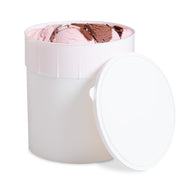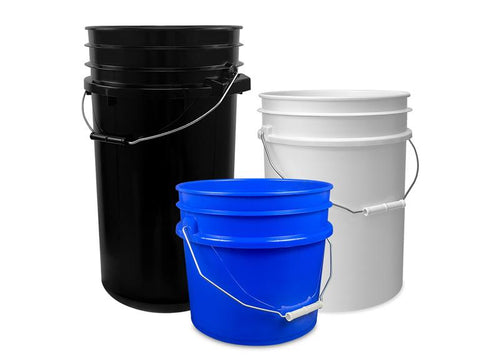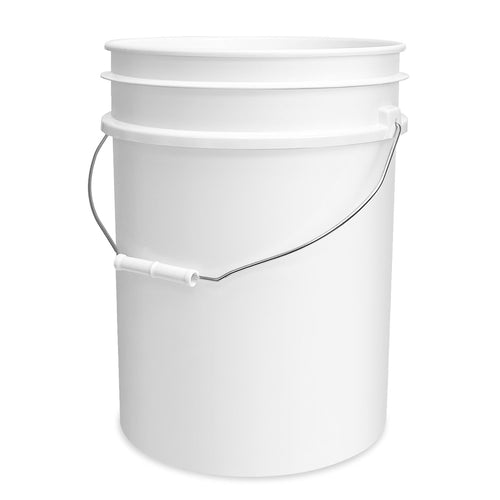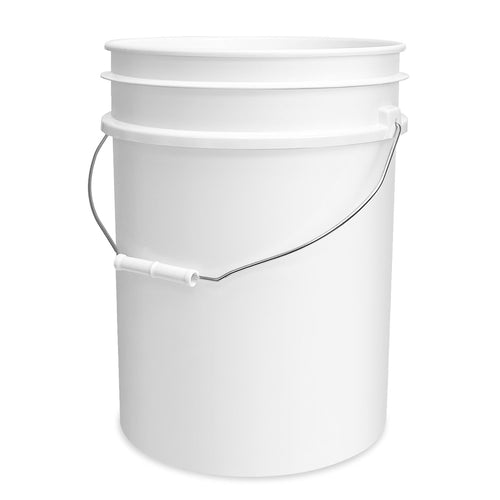Whether you're a farmer, restaurant owner, or someone looking to store food safely at home, food grade buckets are essential for keeping your provisions fresh and uncontaminated. Before embarking on your food storage journey, several important considerations can help you avoid harmful or costly mistakes. This guide explores how to identify food grade buckets and explains the key differences between food grade and regular buckets to ensure the safety of your stored food.
Understanding the differences between standard and food grade buckets can significantly impact the safety and longevity of your stored food items.
Explore Our Food Grade Storage Solutions
FDA-approved, BPA-free buckets and containers for safe food storage.
How To Tell if a Bucket is Food Grade
Are all 5-gallon buckets food grade? In short, no. Food grade buckets are manufactured with special materials designed to keep food untainted and unspoiled. For example, storing food in a 5-gallon paint bucket would be inadvisable since paint buckets are designed for non-food items and aren't made with food-safe materials. Understanding the different types of food grade plastics and how to identify food safe buckets is crucial for proper food storage.
Key Point: Never use buckets originally designed for chemicals, paints, or other non-food products for food storage, even after cleaning. These containers may contain residues or be made from materials that can leach harmful substances into food.
Key Indicators of Food Grade Buckets
There are several reliable ways to identify food grade buckets:
1. Recycling Symbol and Plastic Type
The easiest way to determine if a bucket is food grade is to check the recycling symbol on the bottom. Look for the triangular recycling symbol with a number inside. Food safe plastics are typically numbered 1, 2, 4, or 5.
2. FDA Compliance and Food Safe Symbols
In the United States, what matters most is whether the bucket's materials and manufacturing process comply with FDA food-contact standards. Look for markings like "FDA approved," "USDA approved," or explicit "food grade" labeling on the bucket or its packaging. Read our full explainer on why food-grade packaging doesn't require a label in the USA.
You may also see a cup and fork symbol on some food grade buckets. However, it's important to note that this symbol is primarily a European Union (EU) requirement, not a U.S. FDA requirement. While some manufacturers include this symbol on buckets sold in the U.S., its absence does not mean the bucket isn't food grade. Many FDA-compliant food grade buckets sold in the U.S. don't display this symbol.
Understanding Food Safe Symbols
The cup and fork symbol is common in Europe but not required in the U.S. Look for FDA compliance statements or contact the manufacturer to verify food grade status.
3. Product Labeling and Manufacturer Information
The most reliable way to confirm food grade status is through explicit "food grade" or "food safe" labeling on the bucket or its packaging. When purchasing new buckets, reputable suppliers will clearly indicate FDA compliance in the product description. If you're unsure, contact the manufacturer directly to verify that their buckets meet FDA food-contact requirements.
4. Additional Safety Symbols
Some food grade buckets display additional symbols related to specific uses:
- Radiation waves/squiggly lines - indicates microwave safety
- Snowflake - shows that the bucket is freezer safe
- Dishes in water - means the container is dishwasher safe
What is Food Grade Plastic?
Food grade plastic refers to plastic materials that undergo strict regulation to ensure they're safe for food storage. The shape, size, and color of a bucket are irrelevant as long as the bucket is made from approved food grade plastic material.
Food Grade Plastic Materials:
#1 - Polyethylene Terephthalate (PET or PETE)
PETE is lightweight, strong, and often transparent. Commonly used for beverage bottles and some food containers.
#2 - High-Density Polyethylene (HDPE)
HDPE represents the most common plastic type used for food storage due to its extreme stability and inertness. An HDPE bucket is among the most reliable options available for food storage. Most food grade buckets utilize this plastic type.
#4 - Low-Density Polyethylene (LDPE)
LDPE provides a thinner and more flexible version of HDPE, often used for squeeze bottles and some storage containers.
#5 - Polypropylene (PP)
Polypropylene offers heat resistance and is commonly used to store or transfer hot food items. This makes it ideal for microwave-safe containers.
Regular buckets often utilize #7 plastic, a catch-all category indicating a mixture of recyclable materials. These plastics may contain components that can leach into stored food. Importantly, regular buckets might carry a #2 marking, but this alone doesn't guarantee food grade status due to other manufacturing factors discussed below.
What Is the Difference Between Food Grade Buckets and Regular Buckets?
The differences between food grade buckets and regular buckets can be categorized into three main areas: the type of material used in manufacturing, the method by which the bucket is released from its mold, and the dye used for coloring.
1. Bucket Material
As detailed above, food grade buckets are made from specific types of plastic (recycling numbers 1, 2, 4, or 5) that are safe for food contact. The primary distinction is that these materials remain free from chemicals that could potentially contaminate food items when in contact.
2. Chemicals Used in the Manufacturing Process
Bucket manufacturing typically employs blow molding or injection molding processes. The plastic is heated until malleable enough to conform to the mold shape. Once cooled, the plastic retains the mold's form. However, extracting the plastic requires a release agent; without it, the plastic would permanently adhere to the mold. Before pouring hot plastic into the mold, the mold surface receives a release agent treatment.
For food grade designation, every manufacturing process aspect must be non-toxic to account for potential residue. Common release agent categories include:
Common Release Agents:
- Petroleum and mineral oil-based
- Synthetic and semi-synthetic-based
- Natural-based (e.g., vegetable oil or animal fat)
- Silicone-based
- Wax or stearate-based
Some release agents, particularly synthetic or petroleum-based varieties, can pose significant health hazards if food products contact the residue before human or animal consumption.
Food grade buckets utilize release agents that are safe and non-toxic. Regular buckets may employ release agents that leave toxic residue which, while acceptable for incidental contact, presents risks for food storage applications.
Quick Tip: Even with food grade buckets, it's advisable to wash them thoroughly before first use. This extra precaution helps remove any manufacturing dust or residue that might remain on the surface.
3. Dyes and Coloration
Brightly colored buckets offer aesthetic appeal and practical benefits, such as enabling color-coded storage systems. However, like release agents, dyes can affect a bucket's food grade status.
Regular buckets commonly feature blue, orange, or black coloration, while food grade buckets typically come in white. White buckets contain no dyes or colorants, eliminating potential food contamination from toxic dyes. Food-safe dyes do exist, allowing colored food grade buckets when manufactured with appropriate food grade dyes. Always verify a bucket's "food grade" designation from the supplier before using colored buckets for food storage.
4. Thickness and Construction
Food grade buckets tend to be thicker than regular buckets to better protect the food contents. Standard food grade buckets are typically around 90 mil thick, providing durability and protection for long-term food storage.
5. BPA Considerations
Bisphenol A (BPA) is a chemical used in certain plastics manufacturing since the 1960s. While considered safe at very low consumption levels by the FDA, health concerns have prompted many consumers to seek BPA-free options.
Another crucial consideration for food grade plastics is BPA content. While considered safe at very low consumption levels, health concerns have prompted many consumers to seek BPA-free options. Look for products explicitly marked "BPA-free" for added safety.
Can You Store Food in Regular Buckets?
While technically possible, storing food in regular buckets is not recommended for several important reasons:
- Regular buckets may contain materials that can leach harmful chemicals into food
- The manufacturing process might have used toxic release agents
- Dyes used in colored buckets might not be food-safe
- The plastic composition might not be stable enough for long-term food contact
For safety and peace of mind, always use proper food grade containers for food storage.
Are 5-Gallon Paint Buckets Food Safe?
Most 5-gallon paint buckets are not food safe. Even if a paint bucket is made from a plastic type that could be used for food grade containers (like #2 HDPE), these buckets are manufactured with different release agents and may contain residues from their intended use. Never use a bucket previously used for paint or other chemicals for food storage, even after thorough cleaning.
In the Market for Food Grade Storage Buckets? Use ePackageSupply
We hope this article addressed your questions about food grade buckets and how to identify them. If you need food grade buckets made in the USA, explore ePackageSupply's offerings. All our products meet FDA food-contact standards and are ideal for prepping, serving, and storage needs. As a veteran-owned business based in Evansville, Indiana, we provide BPA-free food grade buckets and other food storage solutions with no minimum order requirement. We also provide custom labeling services to help you organize your storage system effectively.
Key Points About Food Grade vs. Regular Buckets
- Food grade buckets use specific plastic types (#1, #2, #4, or #5) that won't contaminate contents
- In the U.S., FDA compliance is what determines food grade status—not specific symbols
- The cup and fork symbol is an EU requirement; its absence doesn't mean a bucket isn't food grade
- Look for explicit "food grade" designation or contact manufacturers to verify FDA compliance
- Manufacturing processes for food grade buckets use non-toxic release agents
- Food grade buckets are typically white or use food-safe dyes if colored
- Food grade buckets tend to be thicker for better food protection
- BPA-free certification provides additional safety assurance
- Never repurpose paint buckets or other non-food grade containers for food storage
Explore Our Food Grade Storage Solutions
FDA-approved, BPA-free buckets and containers for safe food storage.

















































